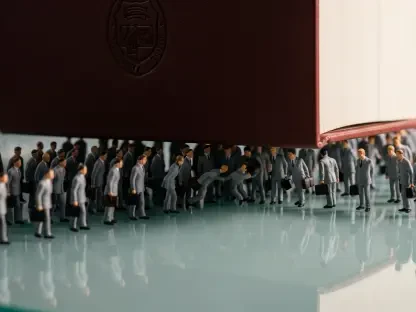In a world increasingly driven by technology and innovation, nurturing the next generation of scientists, engineers, and mathematicians has never been more critical, and the Tapia STEM Camps, hosted by the Tapia Center at Rice University, stand at the forefront of this mission by transforming lives. These impactful programs have reached over 1,200 students globally, igniting a passion for science, technology, engineering, and mathematics (STEM) among young minds from diverse backgrounds. Named after Richard Tapia, a pioneering professor and advocate for inclusivity in STEM fields, the camps have evolved from a small local initiative into a worldwide platform that champions accessibility and opportunity. By offering hands-on learning, real-world problem-solving, and a glimpse into college life, they empower participants to envision themselves as future leaders in these critical areas. This remarkable growth and impact reflect a deep commitment to breaking down barriers and fostering talent, ensuring that STEM becomes a field open to all who dare to dream.
Fostering Inclusivity in STEM Education
The Tapia STEM Camps are built on a foundation of inclusivity, striving to make STEM accessible to students from all walks of life. Each year, over 500 participants in grades eight through 12 travel from distant corners of the globe, including England and Thailand, to attend these camps, while an additional 750 students in the Gulf Coast region benefit from curriculum support. This extensive outreach underscores a powerful message that STEM is not an exclusive domain but a space for everyone, regardless of geographic or socioeconomic background. Collaborators, such as Michael Butler from ExxonMobil, reinforce this ethos by highlighting that talent in these fields knows no boundaries. The camps actively work to dismantle historical underrepresentation, creating a vibrant community where diversity fuels innovation and every student is given the tools to succeed.
Beyond mere participation numbers, the emphasis on inclusivity shapes the very fabric of the Tapia STEM Camps’ mission. The program deliberately targets students from varied communities, ensuring that those who might otherwise lack access to high-quality STEM education are given a chance to shine. This approach not only broadens the talent pool but also enriches the learning environment with diverse perspectives. By fostering an atmosphere where differences are celebrated, the camps encourage participants to see themselves as integral parts of the STEM world. This commitment to equity is evident in every aspect of the program, from recruitment strategies to the supportive networks established among campers, proving that creating opportunities for all can lead to groundbreaking advancements in science and technology.
Blending Technical Learning with Essential Skills
A hallmark of the Tapia STEM Camps is their innovative approach to education, which seamlessly integrates technical STEM knowledge with vital life skills. Students are not confined to textbooks or lectures; instead, they dive into interactive projects that demand creativity and collaboration, such as designing models for carbon capture using everyday materials like pasta and Play-Doh through initiatives like the Tapia Carbon Project. These activities tackle pressing global issues like climate change while teaching practical applications of scientific concepts. Additionally, participants hone their abilities in public speaking and teamwork, often culminating in presentations to peers and distinguished figures like Richard Tapia himself. This dynamic blend ensures that learning extends beyond theory into real-world impact.
Equally important is how the camps prepare students for the interpersonal demands of STEM careers. The focus on communication and collaboration equips participants with the confidence to articulate ideas and work effectively in groups, skills that are just as crucial as technical expertise in professional settings. By engaging in projects that require presenting solutions and defending concepts, campers develop a well-rounded skill set that sets them apart as future innovators. This holistic educational model recognizes that success in STEM is not solely about mastering formulas or code but also about connecting with others and navigating complex challenges. The result is a generation of thinkers who are as adept at solving equations as they are at inspiring and leading teams.
Immersing Students in the College Experience
One of the most impactful elements of the Tapia STEM Camps is the opportunity for participants to experience college life firsthand at Rice University. Living in dorms, dining in campus halls, and attending classes in the same spaces as university students, campers gain an authentic taste of higher education. This immersion, as emphasized by Paul Hand, executive director of the Tapia Center, plays a pivotal role in demystifying the academic world for many who may not have previously considered it within reach. For students like Mylan Bavin from Dallas, this experience transforms abstract dreams of attending prestigious institutions into tangible goals, fueling their determination to pursue advanced studies in STEM fields.
The value of this university exposure cannot be overstated, as it bridges the gap between aspiration and reality for young learners. By interacting with current Rice students and faculty, participants build a clearer picture of the academic and social aspects of college, from rigorous coursework to vibrant campus communities. This firsthand perspective often sparks a profound shift in mindset, encouraging campers to envision themselves thriving in such environments. The camps thus serve as a powerful catalyst, not only inspiring academic ambition but also providing a roadmap for navigating the journey to higher education. This unique aspect ensures that students leave with more than just technical knowledge—they carry a renewed sense of purpose and possibility.
Drawing Inspiration from a STEM Pioneer
Central to the ethos of the Tapia STEM Camps is the remarkable legacy of Richard Tapia, whose life and career embody the spirit of perseverance and advocacy. His guiding principle—that true success lies not in the education one acquires but in how it is applied—resonates deeply with participants, urging them to embrace challenges and learn from failures. As the first Hispanic elected to the National Academy of Engineering and a recipient of the National Medal of Science, Tapia’s groundbreaking achievements provide a living testament to the power of determination. His dedication to supporting underrepresented groups in STEM infuses the camps with a mission to uplift and inspire, making him a role model for every camper aiming to make a mark in these fields.
This personal philosophy translates into a camp culture that prioritizes resilience and purpose over mere accolades. Students are encouraged to see setbacks as stepping stones, mirroring Tapia’s own journey of overcoming barriers to achieve historic milestones. His presence and involvement in the program add a layer of inspiration, as campers witness firsthand the impact of using education for the greater good. This focus on actionable success ensures that participants are not just learning for grades but are motivated to contribute meaningfully to society through STEM. Tapia’s influence thus extends beyond his accolades, shaping a mindset among young innovators that values impact and inclusivity as much as innovation itself.
Strengthening Impact Through Strategic Collaborations
The expansive reach and sustained success of the Tapia STEM Camps are significantly bolstered by robust partnerships with leading organizations. ExxonMobil, a collaborator for over eight years, alongside entities like the H-E-B Tournament of Champions Charitable Trust and Lyda Hill Philanthropies, provides critical resources that enhance the program’s capacity to serve more students. These alliances reflect a shared recognition of the importance of early STEM education in building a diverse and skilled workforce. By pooling expertise and funding, these partners enable the camps to maintain high-quality programming and extend opportunities to regions and communities that might otherwise be overlooked, amplifying the initiative’s transformative potential.
Moreover, these collaborations highlight a broader societal commitment to nurturing talent from an early age. The support from corporate and philanthropic entities ensures that the camps can innovate their curriculum, expand their geographic scope, and offer scholarships to deserving students. This collective effort creates a ripple effect, as each participant inspired by the program carries forward the potential to influence others in their own communities. The partnerships also serve as a model for how public and private sectors can unite around a common goal of educational equity, demonstrating that systemic change in STEM representation is achievable through sustained cooperation and investment.
Reflecting on a Legacy of Transformation
Looking back, the Tapia STEM Camps have proven to be a catalyst for change, having inspired over 1,200 students across the globe to pursue paths in science, technology, engineering, and mathematics with confidence and purpose. Their commitment to inclusivity, hands-on learning, and immersive college experiences has reshaped how young minds perceive their potential in these fields. Moving forward, the challenge lies in scaling this impact even further—perhaps by leveraging digital platforms to reach more remote areas or by forging additional partnerships to fund expanded programming. The enduring influence of Richard Tapia’s vision continues to guide this journey, reminding all involved that STEM’s future depends on empowering every aspiring innovator. As these camps evolve, they stand poised to address emerging educational needs, ensuring that the spark of curiosity lit in each camper grows into a flame of lasting contribution.









